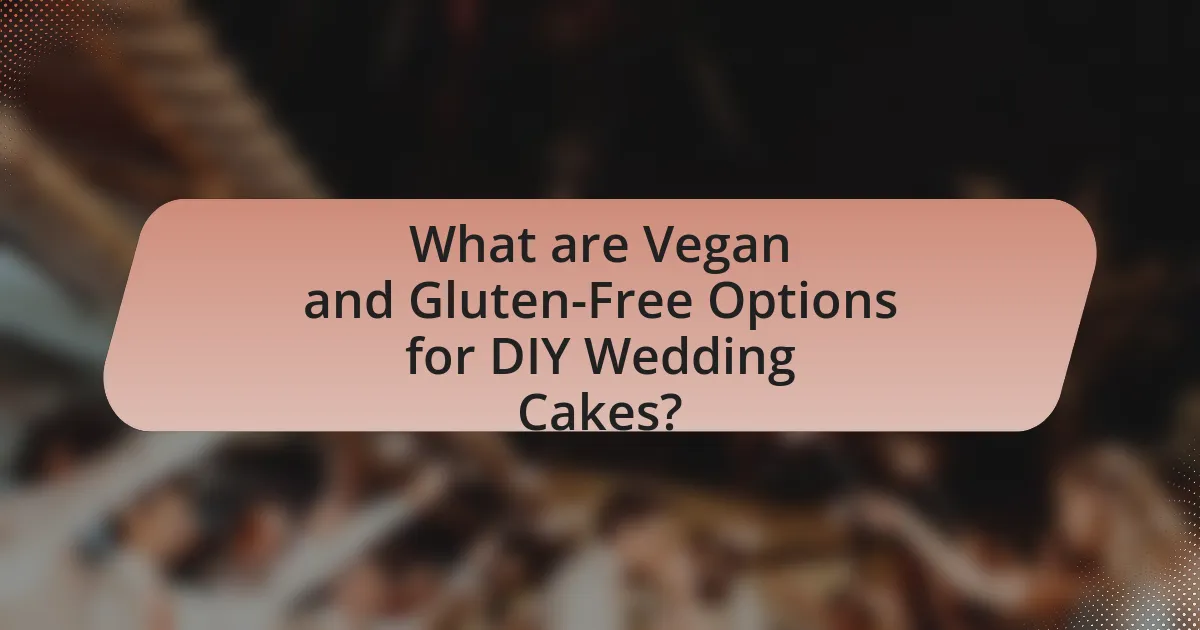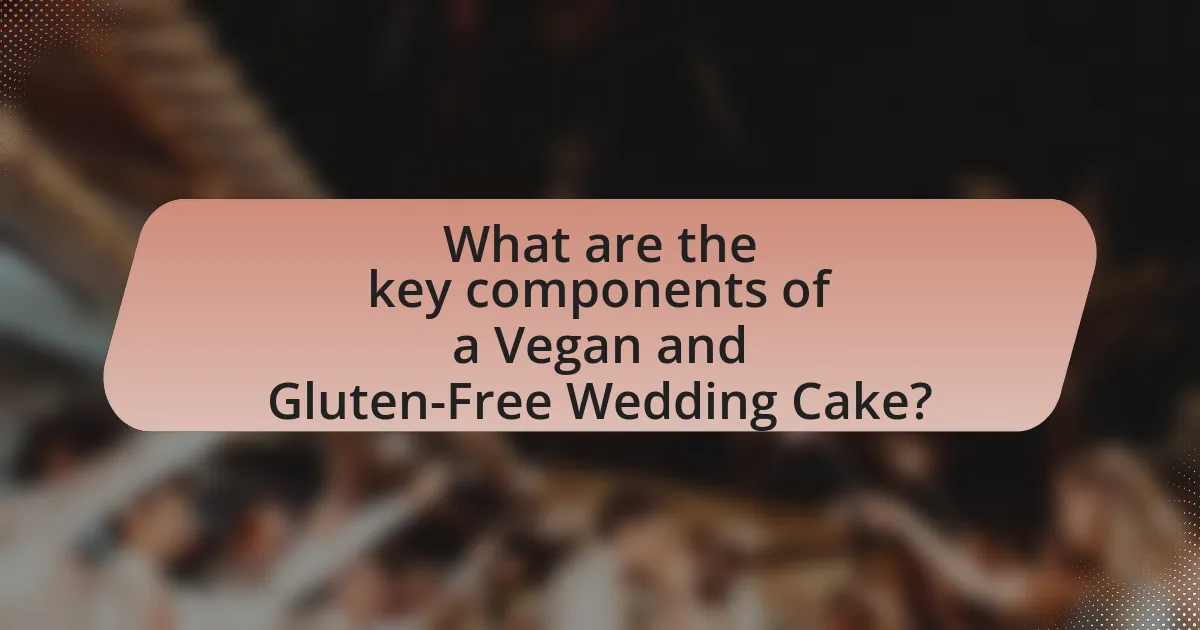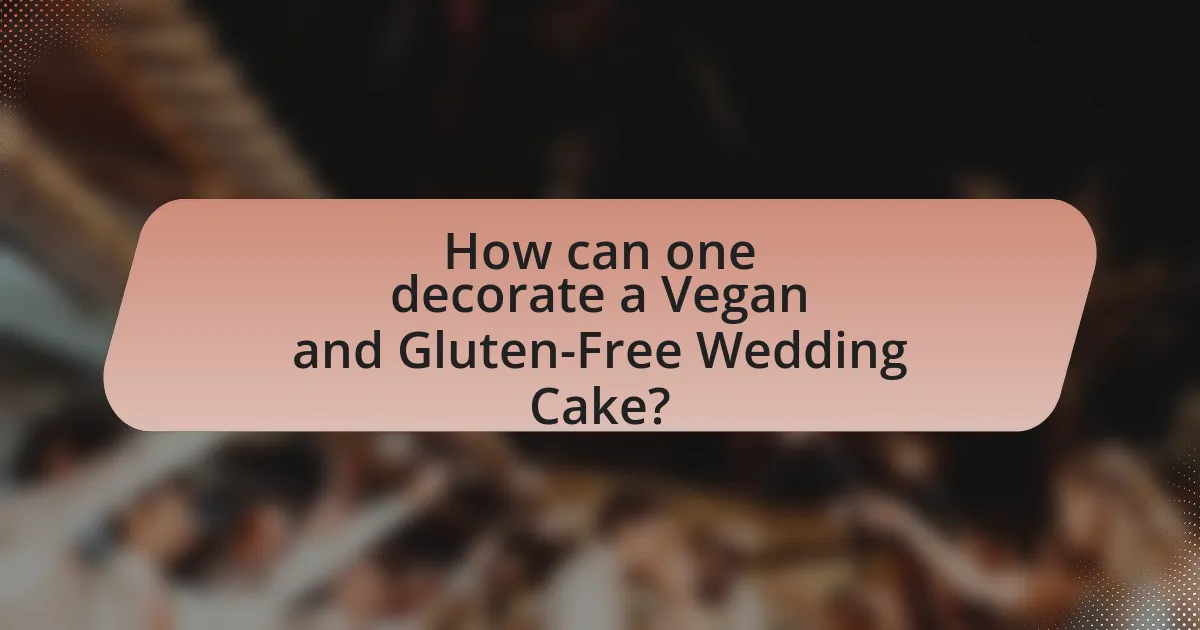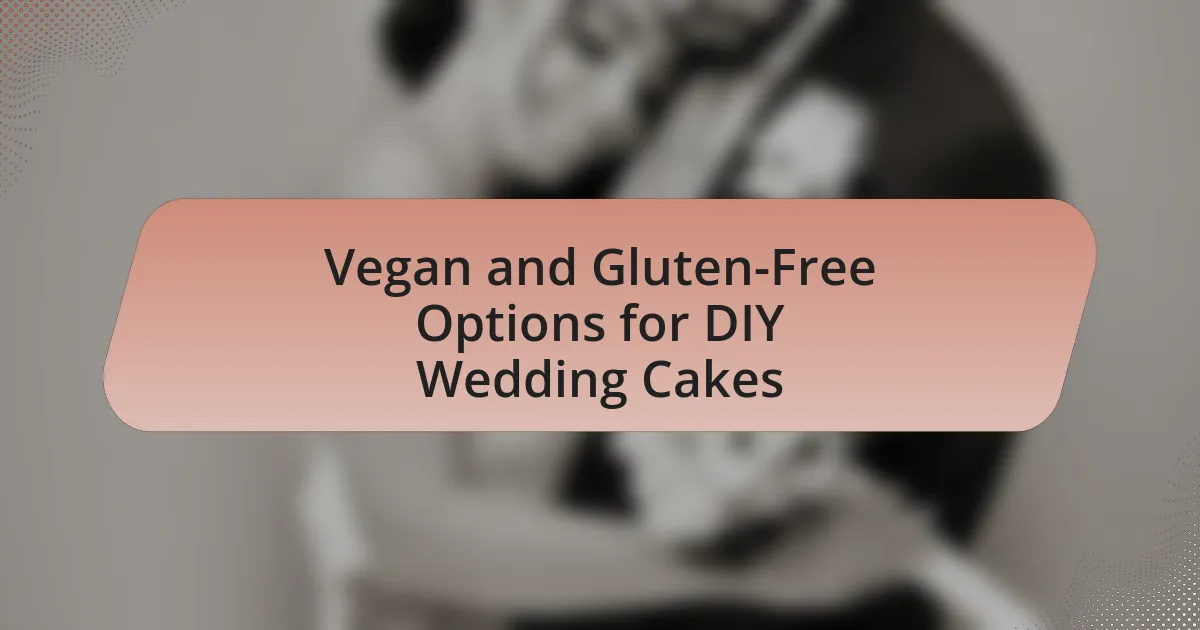Vegan and gluten-free options for DIY wedding cakes cater to dietary restrictions while providing delicious alternatives to traditional cakes. Key ingredients include gluten-free flours such as almond and coconut flour, along with plant-based substitutes for eggs and dairy, ensuring a suitable texture and flavor. The article explores common substitutes for eggs, the best gluten-free flours for baking, and various recipes that meet vegan and gluten-free standards. Additionally, it discusses the health benefits associated with these diets, decoration ideas, and practical tips for successful baking and transportation of the cakes.

What are Vegan and Gluten-Free Options for DIY Wedding Cakes?
Vegan and gluten-free options for DIY wedding cakes include using almond flour, coconut flour, or gluten-free all-purpose flour as the base, combined with plant-based ingredients like applesauce, flaxseed meal, or aquafaba for moisture and binding. These alternatives provide a suitable texture and flavor while adhering to vegan and gluten-free dietary restrictions. For example, a cake made with almond flour and sweetened with maple syrup can be both delicious and compliant with these dietary needs.
How do vegan and gluten-free ingredients differ from traditional cake ingredients?
Vegan and gluten-free ingredients differ from traditional cake ingredients primarily in their sources and composition. Traditional cake ingredients typically include eggs, dairy, and wheat flour, which provide structure, moisture, and flavor. In contrast, vegan cakes replace eggs and dairy with plant-based alternatives such as applesauce, flaxseed meal, or almond milk, while gluten-free cakes utilize alternative flours like almond flour, coconut flour, or rice flour instead of wheat flour. This shift in ingredients not only caters to dietary restrictions but also alters the texture and taste profile of the cake. For example, gluten-free flours often require additional binding agents, such as xanthan gum, to mimic the elasticity provided by gluten in traditional recipes.
What are common substitutes for eggs in vegan baking?
Common substitutes for eggs in vegan baking include flaxseed meal, chia seeds, applesauce, mashed bananas, silken tofu, and commercial egg replacers. Flaxseed meal and chia seeds can be mixed with water to create a gel-like consistency that mimics the binding properties of eggs, with a typical ratio of one tablespoon of seeds to three tablespoons of water. Applesauce and mashed bananas provide moisture and sweetness, with a quarter cup replacing one egg. Silken tofu can be blended until smooth to serve as a dense binding agent, while commercial egg replacers are specifically formulated to replace eggs in baking, often containing starches and leavening agents. These substitutes effectively fulfill the roles of eggs in vegan recipes, ensuring successful baking outcomes.
Which gluten-free flours are best for cake making?
The best gluten-free flours for cake making are almond flour, coconut flour, and gluten-free all-purpose flour. Almond flour provides moisture and a rich flavor, making it ideal for dense cakes. Coconut flour is highly absorbent and works well in combination with other flours to create light textures. Gluten-free all-purpose flour blends typically contain a mix of rice flour, tapioca starch, and potato starch, offering a versatile option that mimics traditional flour in texture and taste. These flours are widely recognized in gluten-free baking for their ability to produce successful cake outcomes.
Why choose vegan and gluten-free options for wedding cakes?
Choosing vegan and gluten-free options for wedding cakes accommodates dietary restrictions and promotes inclusivity among guests. Vegan cakes eliminate animal products, making them suitable for those following plant-based diets, while gluten-free cakes cater to individuals with celiac disease or gluten intolerance. According to the National Foundation for Celiac Awareness, approximately 1 in 100 people worldwide have celiac disease, highlighting the importance of offering gluten-free options. Additionally, vegan baking often utilizes healthier ingredients, such as fruits and nuts, which can enhance the nutritional profile of the cake.
What health benefits are associated with vegan and gluten-free diets?
Vegan and gluten-free diets offer several health benefits, including improved heart health and better digestion. Research indicates that vegan diets are associated with lower cholesterol levels and reduced risk of heart disease due to their high content of fruits, vegetables, whole grains, and legumes, which are rich in fiber and antioxidants. Additionally, gluten-free diets can alleviate symptoms of celiac disease and gluten sensitivity, leading to improved gastrointestinal health. A study published in the Journal of Nutrition found that individuals following a vegan diet had a 32% lower risk of heart disease compared to those consuming meat. Furthermore, a review in the American Journal of Gastroenterology highlighted that a gluten-free diet significantly improves symptoms in patients with gluten-related disorders.
How do these options cater to dietary restrictions of guests?
Vegan and gluten-free options for DIY wedding cakes specifically cater to dietary restrictions by eliminating animal products and gluten, making them suitable for guests with vegan diets and gluten sensitivities or celiac disease. These options often utilize alternative ingredients such as almond flour, coconut flour, or gluten-free blends, which provide a safe and enjoyable dessert for those with these dietary needs. Additionally, many recipes incorporate natural sweeteners and plant-based substitutes, ensuring that the cakes remain delicious while adhering to the dietary restrictions of guests.

What are the key components of a Vegan and Gluten-Free Wedding Cake?
The key components of a Vegan and Gluten-Free Wedding Cake include gluten-free flour, plant-based milk, natural sweeteners, and egg substitutes. Gluten-free flour, such as almond flour or coconut flour, serves as the base, while plant-based milk like almond or soy milk provides moisture. Natural sweeteners, such as maple syrup or agave nectar, replace refined sugars, and egg substitutes like flaxseed meal or applesauce act as binding agents. These components ensure the cake meets both vegan and gluten-free dietary requirements, making it suitable for a diverse range of guests.
What types of vegan and gluten-free cake recipes are available?
Vegan and gluten-free cake recipes include options such as almond flour chocolate cake, coconut flour vanilla cake, and chickpea flour lemon cake. These recipes utilize alternative flours to replace traditional wheat flour, ensuring they meet both vegan and gluten-free dietary requirements. For instance, almond flour is rich in protein and healthy fats, making it a popular choice for moist cakes, while coconut flour absorbs moisture well, resulting in a light texture. Additionally, chickpea flour provides a unique flavor and is high in fiber, contributing to the cake’s nutritional value.
How can one create a classic vanilla vegan and gluten-free cake?
To create a classic vanilla vegan and gluten-free cake, combine gluten-free flour, baking powder, and salt in a bowl. In a separate bowl, mix plant-based milk, vegetable oil, vanilla extract, and a sweetener like maple syrup or coconut sugar. Gradually add the dry ingredients to the wet mixture, stirring until smooth. Pour the batter into a greased cake pan and bake at 350°F (175°C) for 25-30 minutes, or until a toothpick inserted in the center comes out clean. This method ensures the cake is both vegan and gluten-free, as it avoids animal products and gluten-containing ingredients.
What are some creative flavor combinations for vegan and gluten-free cakes?
Creative flavor combinations for vegan and gluten-free cakes include chocolate and avocado, lemon and lavender, and coconut and pineapple. Chocolate and avocado create a rich, moist texture while providing healthy fats, making it a popular choice. Lemon and lavender offer a refreshing and aromatic profile, ideal for spring or summer weddings. Coconut and pineapple evoke tropical flavors, perfect for a light and fruity cake. These combinations not only cater to dietary restrictions but also enhance the overall taste experience, appealing to a wide range of palates.
What are the essential tools and equipment needed for baking?
The essential tools and equipment needed for baking include mixing bowls, measuring cups and spoons, a whisk, a spatula, a rolling pin, baking sheets, and an oven. Mixing bowls are crucial for combining ingredients, while measuring cups and spoons ensure accurate ingredient quantities, which is vital for successful baking. A whisk is necessary for incorporating air into mixtures, and a spatula aids in scraping bowls and folding ingredients. A rolling pin is essential for rolling out dough, and baking sheets provide a surface for cookies and other baked goods. Finally, an oven is required for baking the items at the correct temperature, which is fundamental for achieving the desired texture and flavor in baked goods.
Which baking pans are suitable for gluten-free cakes?
Metal baking pans, particularly those made of aluminum or stainless steel, are suitable for gluten-free cakes. These materials provide even heat distribution, which is essential for proper baking. Additionally, silicone baking pans are also a good option as they allow for easy release of gluten-free cakes, which can be more delicate than traditional cakes. Research indicates that using the right baking pan can significantly affect the texture and rise of gluten-free baked goods, making metal and silicone pans the preferred choices for achieving optimal results.
How can one ensure proper mixing and baking techniques for these cakes?
To ensure proper mixing and baking techniques for vegan and gluten-free cakes, one should use a combination of precise measurements and appropriate mixing methods. Accurate ingredient ratios are crucial, as gluten-free flours absorb moisture differently than wheat flour; for example, using a blend of almond flour and coconut flour can provide the right texture.
Mixing should be done gently to avoid overworking the batter, which can lead to a dense cake. Incorporating wet and dry ingredients separately, and folding them together, helps maintain airiness. Baking at the correct temperature, typically around 350°F, is essential for even cooking, and using an oven thermometer can verify accuracy.
Additionally, allowing the cake to cool completely before removing it from the pan prevents breakage, which is particularly important for gluten-free cakes that can be more fragile. These techniques are supported by baking science, which emphasizes the importance of ingredient interaction and temperature control in achieving the desired cake structure and flavor.

How can one decorate a Vegan and Gluten-Free Wedding Cake?
To decorate a Vegan and Gluten-Free Wedding Cake, one can use plant-based frosting made from ingredients like coconut cream, cashew cream, or aquafaba, which are suitable for both dietary restrictions. Edible flowers, fresh fruits, and nuts can serve as natural decorations, enhancing the cake’s visual appeal while adhering to vegan and gluten-free standards. Additionally, using gluten-free sprinkles or edible glitter can add a festive touch without compromising dietary needs. These decoration methods not only maintain the integrity of the cake’s ingredients but also provide an aesthetically pleasing presentation that aligns with the theme of the wedding.
What are the best vegan and gluten-free frosting options?
The best vegan and gluten-free frosting options include coconut cream frosting, avocado chocolate frosting, and cashew cream frosting. Coconut cream frosting is made by whipping chilled coconut cream, which provides a rich and creamy texture without gluten or animal products. Avocado chocolate frosting combines ripe avocados with cocoa powder and sweeteners, creating a smooth, chocolatey frosting that is both nutritious and free from gluten. Cashew cream frosting is prepared by blending soaked cashews with plant-based milk and sweeteners, resulting in a versatile and creamy option suitable for various cake flavors. These options are popular among those seeking vegan and gluten-free alternatives for desserts, ensuring both dietary needs and taste preferences are met.
How can one make a vegan buttercream frosting?
To make a vegan buttercream frosting, combine 1 cup of vegan butter with 4 cups of powdered sugar, 2-4 tablespoons of non-dairy milk, and 1 teaspoon of vanilla extract in a mixing bowl. Beat the mixture on medium speed until it is smooth and creamy, adjusting the consistency with more non-dairy milk if necessary. This method is effective because vegan butter serves as a direct substitute for traditional butter, allowing for a similar texture and flavor profile in the frosting.
What natural food colorings can be used for decoration?
Natural food colorings that can be used for decoration include beet juice, turmeric, spirulina, and purple cabbage. Beet juice provides a vibrant red hue, while turmeric offers a bright yellow color. Spirulina, derived from blue-green algae, imparts a green shade, and purple cabbage can be used to create a range of colors, including blue and purple, depending on the pH level. These colorings are derived from plant sources, making them suitable for vegan and gluten-free applications in decorating cakes.
What are some creative decoration ideas for a wedding cake?
Creative decoration ideas for a wedding cake include using fresh flowers, edible glitter, and fruit arrangements. Fresh flowers can enhance the cake’s aesthetic by adding natural beauty and color, while edible glitter provides a touch of sparkle that appeals to modern tastes. Fruit arrangements, such as berries or citrus slices, not only add visual interest but also complement the flavors of vegan and gluten-free cakes. These decoration methods are popular because they are visually striking and can be easily adapted to fit various wedding themes and color palettes.
How can fresh fruits and edible flowers enhance the cake’s appearance?
Fresh fruits and edible flowers can significantly enhance a cake’s appearance by adding vibrant colors, textures, and natural beauty. The use of fresh fruits introduces a variety of hues, such as the deep reds of strawberries or the bright yellows of mangoes, which create visual appeal and contrast against the cake’s base. Edible flowers, like pansies or nasturtiums, contribute delicate shapes and intricate designs, elevating the cake’s aesthetic to a more sophisticated level. Research indicates that visually appealing food can enhance the perception of taste, making the cake not only more attractive but also more desirable to consumers.
What are some tips for achieving a professional finish on the cake?
To achieve a professional finish on a cake, ensure a smooth and even crumb coat before applying the final layer of frosting. A crumb coat, which is a thin layer of frosting, traps loose crumbs and creates a stable base for the final layer. After applying the crumb coat, chill the cake to set it, which helps in achieving a clean finish. Use a bench scraper or an offset spatula to smooth the frosting, applying even pressure while rotating the cake on a turntable. Additionally, using high-quality ingredients, such as vegan butter and gluten-free flour blends, contributes to a better texture and appearance. Properly leveling the cake layers before stacking also ensures a uniform height, enhancing the overall professional look.
What are some practical tips for successfully making a Vegan and Gluten-Free Wedding Cake?
To successfully make a Vegan and Gluten-Free Wedding Cake, use a combination of gluten-free flours such as almond flour, coconut flour, or a gluten-free all-purpose blend to achieve the right texture. Incorporate binding agents like flaxseed meal or chia seeds mixed with water to replace eggs, ensuring moisture and structure. Utilize plant-based milk and natural sweeteners like maple syrup or agave nectar to enhance flavor without compromising dietary restrictions.
For proof, studies indicate that gluten-free flours can provide similar baking properties when combined correctly, and the use of flaxseed as an egg substitute has been widely recognized in vegan baking for its binding capabilities.
How can one troubleshoot common baking issues with vegan and gluten-free cakes?
To troubleshoot common baking issues with vegan and gluten-free cakes, one should first identify specific problems such as dryness, density, or lack of rise. For dryness, increasing moisture by adding more liquid ingredients like plant-based milk or applesauce can help. If the cake is too dense, incorporating a leavening agent like baking soda or baking powder can improve texture. For cakes that do not rise, ensuring the correct ratio of wet to dry ingredients and using fresh leavening agents is crucial. Additionally, using a blend of gluten-free flours, such as almond flour and coconut flour, can enhance the overall structure and flavor. These strategies are supported by baking science, which emphasizes the importance of ingredient balance in achieving desired cake qualities.
What are the best practices for storing and transporting the cake?
The best practices for storing and transporting a cake include keeping it in a cool, dry place and using a sturdy cake box for transport. Cakes should be stored at room temperature if they are to be consumed within a few days, while longer storage requires refrigeration, especially for cakes with perishable fillings. When transporting, ensure the cake is securely placed in a box to prevent movement and damage. Additionally, avoid stacking items on top of the cake during transport to maintain its shape and decoration. These practices help preserve the cake’s texture and flavor, ensuring it arrives at its destination in optimal condition.
